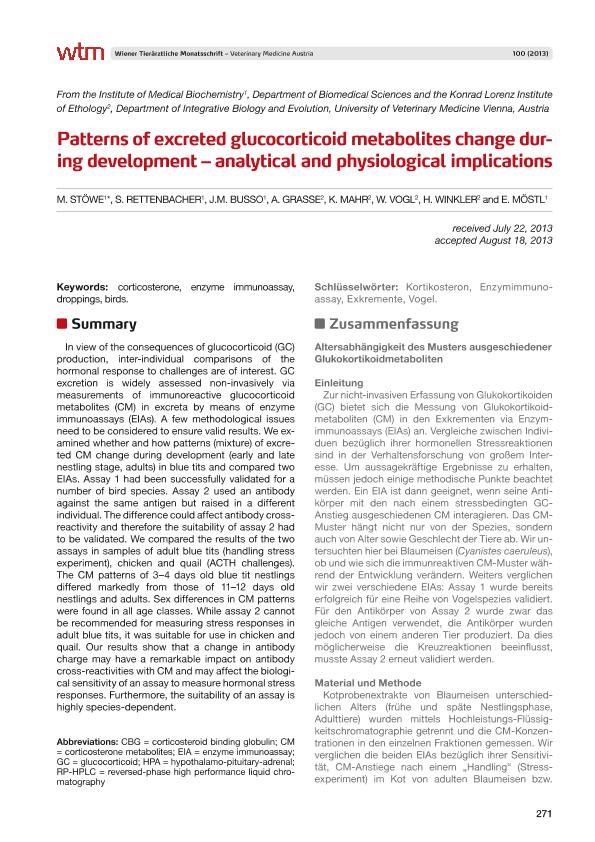Artículo
Patterns of excreted glucocorticoid metabolites change during development - analytical and physiological implications
Stöwe, M.; Rettenbacher, S.; Busso, Juan Manuel ; Grasse, A.; Mahr, K.; Vogl, W.; Winkler, H.; Möstl, E.
; Grasse, A.; Mahr, K.; Vogl, W.; Winkler, H.; Möstl, E.
 ; Grasse, A.; Mahr, K.; Vogl, W.; Winkler, H.; Möstl, E.
; Grasse, A.; Mahr, K.; Vogl, W.; Winkler, H.; Möstl, E.
Fecha de publicación:
08/2013
Editorial:
B W K Publishing Solutions & Verlag
Revista:
Wiener Tierarztliche Monatsschrift
ISSN:
0043-535X
Idioma:
Inglés
Tipo de recurso:
Artículo publicado
Clasificación temática:
Resumen
In view of the consequences of glucocorticoid (GC) production, inter-individual comparisons of the hormonal response to challenges are of interest. GC excretion is widely assessed non-invasively via measurements of immunoreactive glucocorticoid metabolites (CM) in excreta by means of enzyme immunoassays (EIAs). A few methodological issues need to be considered to ensure valid results. We examined whether and how patterns (mixture) of excreted CM change during development (early and late nestling stage, adults) in blue tits and compared two EIAs. Assay 1 had been successfully validated for a number of bird species. Assay 2 used an antibody against the same antigen but raised in a different individual. The difference could affect antibody crossreactivity and therefore the suitability of assay 2 had to be validated. We compared the results of the two assays in samples of adult blue tits (handling stress experiment), chicken and quail (ACTH challenges). The CM patterns of 3–4 days old blue tit nestlings differed markedly from those of 11–12 days old nestlings and adults. Sex differences in CM patterns were found in all age classes. While assay 2 cannot be recommended for measuring stress responses in adult blue tits, it was suitable for use in chicken and quail. Our results show that a change in antibody charge may have a remarkable impact on antibody cross-reactivities with CM and may affect the biological sensitivity of an assay to measure hormonal stress responses. Furthermore, the suitability of an assay is highly species-dependent.
Palabras clave:
Corticosterone
,
Enzyme Immunoassay
,
Droppings
,
Birds
Archivos asociados
Licencia
Identificadores
Colecciones
Articulos(IIBYT)
Articulos de INSTITUTO DE INVESTIGACIONES BIOLOGICAS Y TECNOLOGICAS
Articulos de INSTITUTO DE INVESTIGACIONES BIOLOGICAS Y TECNOLOGICAS
Citación
Stöwe, M.; Rettenbacher, S.; Busso, Juan Manuel; Grasse, A.; Mahr, K.; et al.; Patterns of excreted glucocorticoid metabolites change during development - analytical and physiological implications; B W K Publishing Solutions & Verlag; Wiener Tierarztliche Monatsschrift; 100; 8-2013; 271-282
Compartir



